Hexacorallia or Zoantharia
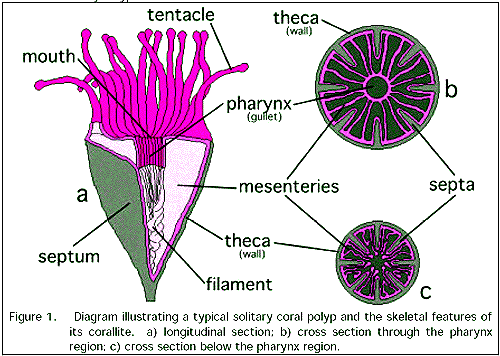 This very important subclass includes six mesenteries or multiples thereof. Included here are sea anemones, true corals, and two similar groups. Sometimes the subclass Zoantharia is used instead, in which case hexacorals are included with Rugose corals Rugosa) and Horny Corals (Cerantipitharia).
This very important subclass includes six mesenteries or multiples thereof. Included here are sea anemones, true corals, and two similar groups. Sometimes the subclass Zoantharia is used instead, in which case hexacorals are included with Rugose corals Rugosa) and Horny Corals (Cerantipitharia).
The following four orders have generally been included:
As of this revision (040930), the most recent phylogeny is that of Daly et al. (2003). Unfortunately, these workers were restricted to living taxa, since they used a combined molecular and morphological approach. Their phylogeny of the hexacorals may represented as follows:
■─┬─Ceriantharia
└─Hexacorallia
├─Actiniaria
└─┬─Zoanthidea
└─┬─Antipatharia
└─┬─Corallimorpharia
└─Scleractinia
The Tabulata and Rugosa are usually assigned positions just basal to the Zoanthidea and Antipatharia. For lack of anything more sensible to do, we insert them so as to preserve that relationship.
The basic anatomy of a coral is shown in the image. Scleractinian larvae (i.e. the planula stage of polyp development) forms a basal plate on a suitable substrate. It then secretes vertical partitions (septa) which are joined by the outer body wall (theca). The septa may meet at the axis during at least part of their vertical extent. If so, they may form a vertical columella in the center. This is common in scleractinian corals, but rare in rugose corals and absent in the Tabulata. In addition, the polyp forms soft tissue partitions or mesenteries. Ultimately, these control the central pharynx which opens on the dorsal surface. The opening of the pharynx is surrounded by a row of tentacles.
Image: from Coral Reefs Biology 200 Lecture Notes and Study Guide by Prof. David A. Krupp of Windward Community College.
ATW040930. Text public domain. No rights reserved.
Actiniaria: sea anemones
From the Cambrian
The soft-bodied sea anemones are large soft-bodied corals. The polyp is usually brightly colored, always solitary, and found in coastal waters world-wide, but are particularly common in the tropics. In size they are usually from 1.5 to 5 cm in diameter, although giant forms like Tealia columbiana (North Pacific USA) and Stoichactus sp. (Great Barrier Reef, Australia) may reach over a meter at the oral (mouth) end.
The outer tentacles are much divided, giving a frilly appearance.
The mouth occurs in the middle of a flat area called the oral disc; the mouth and pharynx below are oval in shape. There are usually two ciliated grooves called siphonoglyphs, found the length of the pharynx, that create a current of water into the "stomach" gastrovascular cavity), which maintains a hydrostatic skeleton, against which the muscles can act.
These are small, solitary or colonial, anemone-like hexacorals. Most forms are tropical, some are common reef inhabitants, and some live attached to other invertebrates. The body may be columnar, but is more often short and button-like. A short fringe of tentacles surrounds a the broad oval disc.
These anthozoans resemble stony corals (Scleractinia) but lack skeletons. In fact, they are consistently classified as the sister group of the Scleractinia by a wide variety of taxonomic methods. However, they secrete no skeleton of any kind. The Corallimorpharia have a flattened adherent base, similar to Scleractinia, but without a base plate or basilar muscles. The theca around the column is smooth, sometimes with weak longitudinal muscles. The sphincter is weak or absent. The tentacles around the mouth are disposed in concentric circles, usually forming a series of radial lines rather than being alternately arranged. Both the muscles of the oral disk and the longitudinal muscles of the tentacles are weak. However, the disk is well-supplied with cilia which create a current carrying suspended materials into the pharynx. The polyps can also form the dorsal surface into a sac, lined with nematocysts to trap and subdue larger prey. The mesenteries are often irregular. Corallimorpharia are often solitary, or connected to other polyps by coenenchyme.
Corallimorpharia are well known to aquarists because of their striking forms and colors, the latter often due to symbiotic zooxanthellae within the tissues of the polyp. In spite of this trait, Corallimorpharia generally prefer low light levels or indirect light. They feed on a wide variety of food materials. All feed on dissolved and particulate matter, some feed on zooplankton, and some are even known to trap and digest fish. Corallimorpharians usually reproduce vegetatively (e.g., by budding or fission), and often form colonies of cloned individuals. Sexual reproduction is assumed to occur, but has not been well documented.
Currently, four families of Corallimorpharia are recognized:
There does not appear to be any good indication of the relative phylogenetic position of these families.
Links: classification_path_2.cfm-taxonname=Corallimorpharia, http://web.nhm.ku.edu/inverts/carlgren_1949/corallimorpharia.html, Order Corallimorpharia (ERMS taxonomic hierarchy), Aquarium Invertebrates, Corallimorpharia looks like great site, but my Icelandic is a bit rusty ...).
ATW040930. Text public domain. No rights reserved.
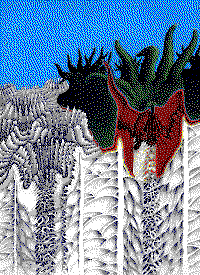 All Mesozoic and Cenozoic reef-building corals are members of this order (sometimes, subclass). Reef-building corals are also known as "hard corals" or "stony corals." They are similar to and closely related to sea anemones but unlike those soft-bodied forms they secrete an aragonitic (calcium carbonate) skeleton. It is this skeleton that forms coral reefs.
All Mesozoic and Cenozoic reef-building corals are members of this order (sometimes, subclass). Reef-building corals are also known as "hard corals" or "stony corals." They are similar to and closely related to sea anemones but unlike those soft-bodied forms they secrete an aragonitic (calcium carbonate) skeleton. It is this skeleton that forms coral reefs.
Some forms, like the Indo-Pacific Fungia, are solitary, with single polyps reaching 25 cm in diameter. The majority however are colonial, with very small polyps (about 1 to 3 mm), although the colony as a whole can grow very large.
As with all the Hexacorallia, septal insertion occurs in multiples of six, and many scleractinial corals have 6-fold symmetry.
Over 60 genera of Scleractinia have a symbiotic relationship with a type of microscopic algae, called zooxanthellae, living within the coral polyp's tissue (within the gastrodermal cells). Although deep water and some cold-water corals lack zooxanthellae, virtually all reef-building possess them. These corals are generally found in clear water at depths of less than 50 meters, the zone where sunlight penetrates. The algae not only provide food but help polyp calcification, and may account for up to 50% of the protein nitrogen of the coral, as well as giving then a yellow-brown or dark brown colour. These so-called hermatypic corals can lay down massive amounts of limestone in the photic zone of shallow tropic seas.
Image: Cross section through a coral organism
Text by M. Alan Kazlev, 1999-2002
page uploaded 16 June 2002
(originally uploaded on Kheper Site 4 June 1999)
checked ATW050611
 This very important subclass includes six mesenteries or multiples thereof. Included here are sea anemones, true corals, and two similar groups. Sometimes the subclass Zoantharia is used instead, in which case hexacorals are included with Rugose corals Rugosa) and Horny Corals (Cerantipitharia).
This very important subclass includes six mesenteries or multiples thereof. Included here are sea anemones, true corals, and two similar groups. Sometimes the subclass Zoantharia is used instead, in which case hexacorals are included with Rugose corals Rugosa) and Horny Corals (Cerantipitharia).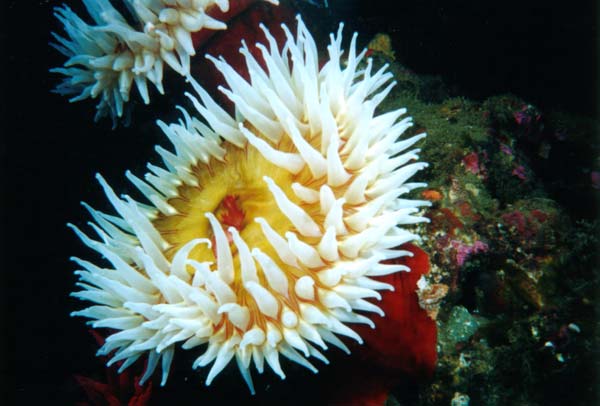
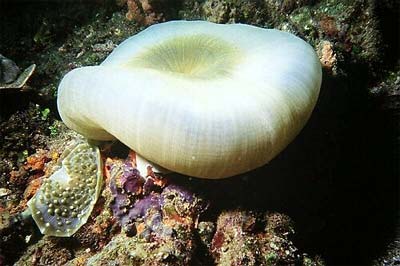

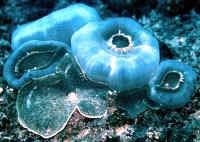


 All Mesozoic and Cenozoic reef-building corals are members of this order (sometimes, subclass). Reef-building corals are also known as "hard corals" or "stony corals." They are similar to and closely related to sea anemones but unlike those soft-bodied forms they secrete an aragonitic (calcium carbonate) skeleton. It is this skeleton that forms coral reefs.
All Mesozoic and Cenozoic reef-building corals are members of this order (sometimes, subclass). Reef-building corals are also known as "hard corals" or "stony corals." They are similar to and closely related to sea anemones but unlike those soft-bodied forms they secrete an aragonitic (calcium carbonate) skeleton. It is this skeleton that forms coral reefs.
